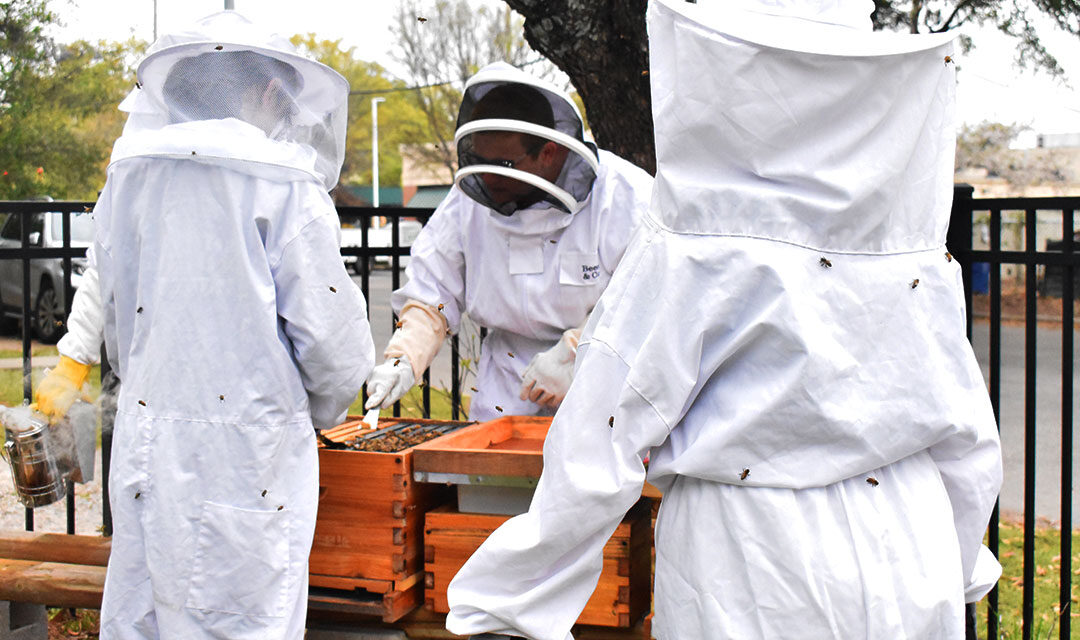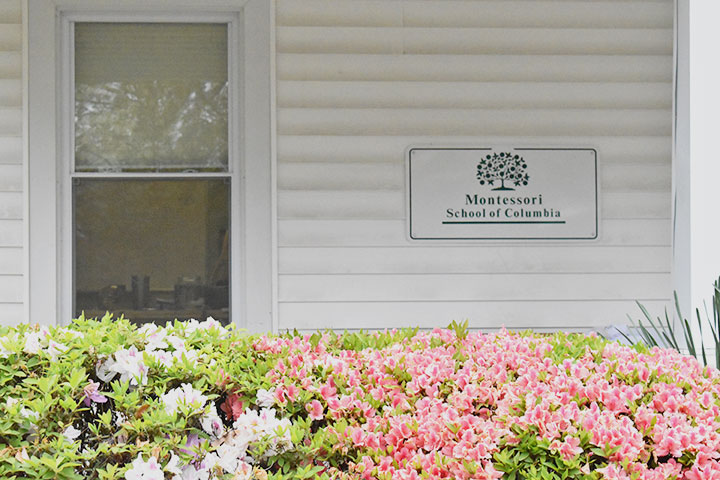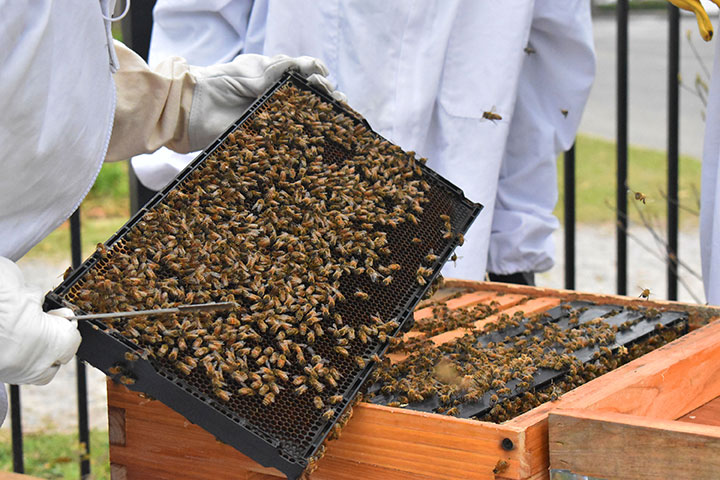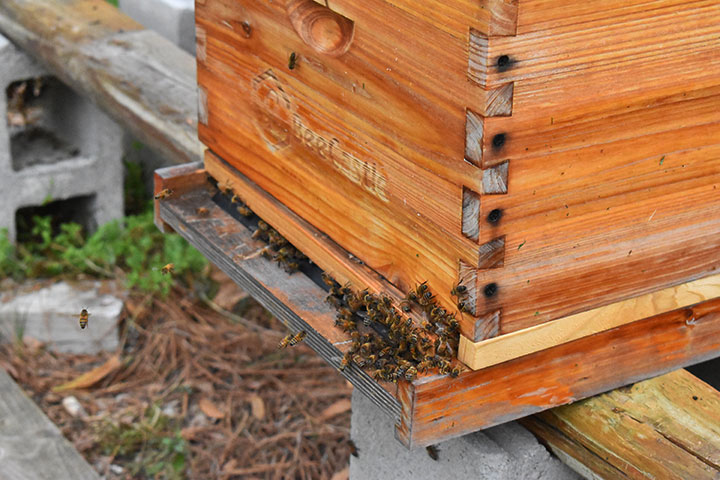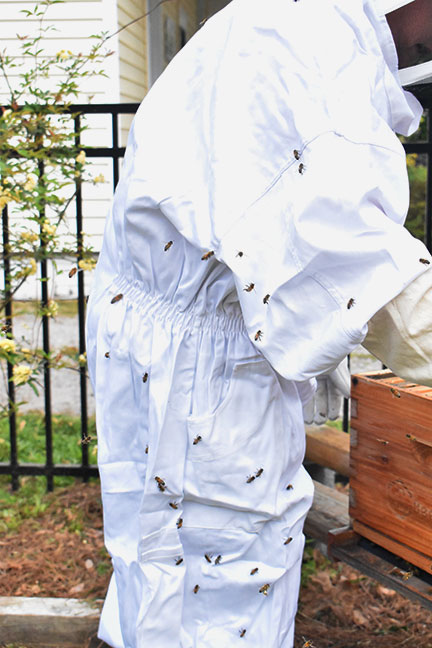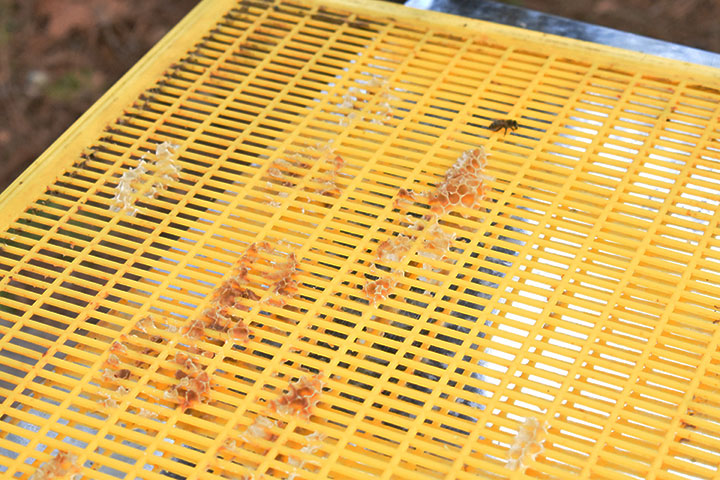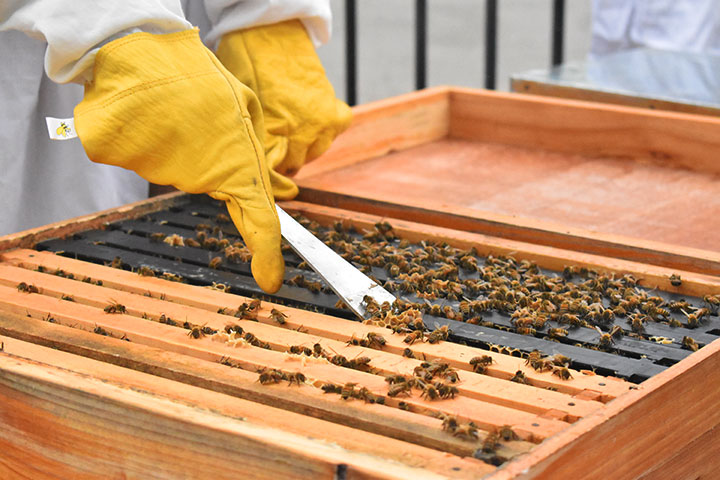The Montessori School of Columbia has a bee-keeping program to educate students on the importance of the ecosystem’s main pollinators. Students Bella and Nai work with teacher Erica Patterson to check on the beehive in the school’s front yard. (Photos by Abby Foncannon)
Bee advocates are stepping up efforts in South Carolina to revitalize native bee species, the country’s main pollinators.
Contrary to popular belief, honey bees are native to Europe. But it’s the bees that are native to North America – mason bees, carpenter bees and sweat bees – that have S.C. advocates concerned.
Those bees do the bulk of the work in pollinating flowers, row crops and trees.
There are several causes to the diminishing of native bee populations: climate change, habitat loss and bee-killing pesticides, called neonicotinoids. Those harmful chemicals are the main contributor and can cause paralysis, navigation problems and death in bees, according to Environment America.
“One in three bites of food on our plates is thanks to a pollinator,” said Emilee Elingburg, the director of educational programs at The Bee Cause Project in Charleston. “We need them not only for our fruits and vegetables but for other types of things that we feed farm animals. … It’s a big thing to look at how they really truly affect all of us.”
Some schools in South Carolina, such as the Montessori School of Columbia, are using hands-on bee-keeping to educate students about the problem.
Eight students in Montessori’s Erdkinder program are learning more about the ecosystem’s main pollinators by tending to the school’s beehive.
Students Bella, Gracie and Nai regularly survey the hive on the school’s front lawn. They do not inspect the hive every day so as to not agitate the bees, but instead open it once or twice a week.
Learning how the beehive works is important to the students’ education.
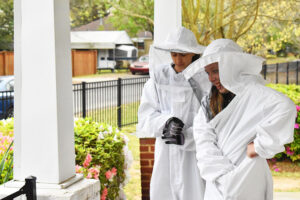
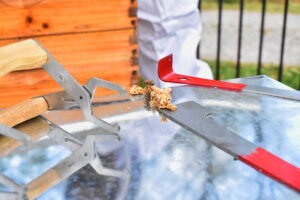
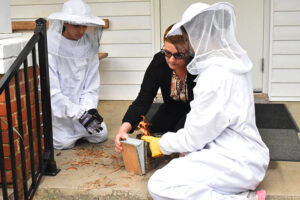
“They’re just super unique,” Gracie said. “They are different from other insects. … We can learn how they work, and that’s pretty cool to learn about.”
Each student has a favorite part about tending the bees.
“I like the buzzing they make,” Bella said. “… They seriously do a lot for humans. Even bee stings can help arthritis.”
“I think they are kind of calming,” Gracie said. “… Even though they (can be) angry at you, once they realize that you are not trying to harm them, they are super nice.”
The students say their favorite part, though, is “just being around them.”
Erica Patterson, the Montessori teacher overseeing the Erdkinder program, is proud of all the work the students have done to educate themselves. She makes certain the most important part of the program is allowing the bees to survive and maintain their resources.
“This is their honey,” Patterson said. “We never harvest this honey.”
The school’s bee-keeping program doesn’t receive funding from grants or sponsors. All the materials are purchased in-house and maintained by the students and teachers.
At The Bee Cause Project in Charleston, several grants are given to schools, nonprofits and libraries that assist in the revitalization of bee populations. The grants include the Traditional Bee Grant, Renewal Bee Grant, Pollinator Literacy Grant and Pollinator Habitat Grant.
The organization’s largest grant is the Traditional Bee Grant. More than 100 new grants are distributed each year.
“That is for schools (and) any organization that’s a nonprofit,” Elingburg said. “It could be a museum, it could be a library. … They apply and tell us how they’re going to create the aviary or bee yard for honey bees in their space.”
Elingburg started at The Bee Cause Project about three years ago. Before that, she worked for 18 years at the East Cooper Montessori Charter School in Charleston.
As the director of educational programs, she sources all possible information – books, links, videos, curriculum – in an online site, OER Commons, to help educators have resources for bee-keeping programs.
“Not everyone is equipped to handle live honey bees,” Elingburg said. “You have to have a bee mentor. You have to have a bee advocate. It definitely requires some knowledge and skill.”
The lessons and tips in OER Commons are free and accessible to all.
“You can create (a) habitat in any space with containers,” Elingburg said. “You can do it on balconies. You can do it on rooftops. And with that, you’re creating those resources that are missing.”
The Montessori School of Columbia adorns its front yard with flowers and trees to assist the pollinators in creating a thriving hive.
The students inspect the beehive and the frames of the Bee Castle box to make sure the bees are healthy and creating honeycomb.
Bees come and go from their Bee Castle box, pollinating flowers and plants in the school’s front lawn.
Bees cling to teacher Erica Patterson’s bee suit after she and the students use smoke to calm the bees to inspect their hive. The bees are relaxed as their home is inspected.
Only a small amount of honeycomb is scrapped from the top of the hive’s frames. It shows how hard the hive is working to survive and thrive.
Montessori student Gracie scraps honeycomb from the top of the Bee Castle frames. This allows the bees to create a cohesive and structured hive in the box.

